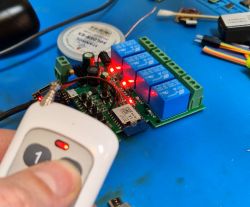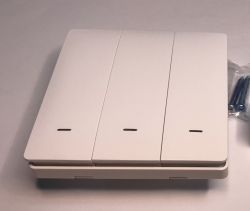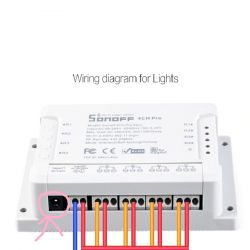FAQ
TL;DR: Cheap 1/2-inch 12 V valves flow about 6–10 L/min; "a 24VAC valve will be a better solution." Power Sonoff on 230 VAC, feed valves via one 12 V PSU, and add 2 A fuses per valve. Schedule channels to run one at a time. [Elektroda, piotr411, post #18716622]
Why it matters: This FAQ helps DIYers wire and choose valves for Sonoff 4CH to automate sequential garden watering safely and reliably.
Quick Facts
- Power Sonoff from 230 VAC in parallel with the 12 V PSU input to reduce coil feedback risk. [Elektroda, Krzysztof Kamienski, post #18707006]
- One 12 VDC power supply can feed all channels; Sonoff 4CH uses relay outputs that switch your supply voltage. [Elektroda, Krzysztof Kamienski, post #18706937]
- 24 VAC control is standard for garden irrigation valves and is easier to source. [Elektroda, krzbor, post #18711298]
- Typical irrigation valve sizes are 3/4–1 inch; 1/2-inch options may restrict flow and some list a 45-minute run limit. [Elektroda, krzbor, post #18712385]
- Low-cost 12 V 1/2-inch valves deliver ~6–10 L/min and heat up on long runs. [Elektroda, piotr411, post #18716622]
Will a Sonoff 4CH handle sequential solenoid valve watering?
Yes. Each Sonoff 4CH channel is a separate relay, so you can schedule channels to run one valve at a time. Configure start times and durations per channel so only one is on during each 30-minute slot. This approach matches the “one-after-another” plan described and confirmed as workable. Ensure proper power and protection as outlined below for reliability and safety. [Elektroda, Krzysztof Kamienski, post #18706909]
Should I choose 12 VDC or 24 VAC irrigation valves?
Choose 24 VAC irrigation valves when possible. The expert noted more corrosion with DC due to electrolysis and recommended small 230/24 V transformers. Quote: “Small 220/24 V transformers would be more appropriate.” 24 VAC valves are the industry norm and pair well with off-the-shelf irrigation hardware. If you already own 12 V DC valves, protect wiring and keep duty cycles modest. [Elektroda, Krzysztof Kamienski, post #18706909]
How do I wire Sonoff 4CH Pro with one 12 V PSU and four valves?
Follow this 3‑step plan:
- Power Sonoff from 230 VAC in parallel with the 12 VDC PSU input. “Preferably power the Sonoff from 220VAC.”
- Route the PSU’s +12 V through each Sonoff relay COM to NO, then to each valve coil.
- Tie all valve negatives to the PSU negative.
This topology reduces back‑EMF reaching Sonoff logic and keeps supply rails stable. Mount fuses near the controller for serviceability. [Elektroda, Krzysztof Kamienski, post #18707006]
Do I need a separate power supply for each valve?
No. Use one adequately rated 12 VDC supply for all valves. The Sonoff 4CH provides relay outputs that simply switch your supply to each valve. Because you plan sequential operation, only one valve draws current at a time. Size the PSU comfortably for a single valve’s load, with margin. Keep wiring neat and grounds common. [Elektroda, Krzysztof Kamienski, post #18706937]
What fuse ratings should I use to protect my irrigation circuits?
Install a 2 A fuse in the circuit of each valve, and another 2 A fuse on the 230 VAC supply to the system. Place fuses close to the controller to simplify troubleshooting and to protect downstream wiring. This adds inexpensive, effective protection against shorts or moisture-related faults in outdoor junction boxes and valve boxes. [Elektroda, Krzysztof Kamienski, post #18707057]
Are 12 V 1/2-inch solenoid valves OK for lawn sprinklers?
They are a poor fit for sprinklers. Expect only about 6–10 L/min, and these valves heat up if held open too long. “A not much more expensive dedicated valve (e.g., PGV100) 24VAC will be a better solution.” Use 24 VAC irrigation valves for higher flow and reliability. Reserve the 12 V 1/2-inch type for low-flow tasks. [Elektroda, piotr411, post #18716622]
Is a 1/2-inch valve a bottleneck for my sprinklers?
Yes, likely. Irrigation valves are typically 1 inch or 3/4 inch. Your 1/2-inch auction valve lacks a flow rating and even lists a 45‑minute run limit. That restriction signals it can throttle flow and isn’t intended for continuous sprinkler duty. Choose a proper irrigation valve with known throughput and no duty‑time limit. [Elektroda, krzbor, post #18712385]
How do I prevent back-EMF from damaging the Sonoff when switching coils?
Power Sonoff from 230 VAC in parallel with the 12 V PSU input. This arrangement isolates the logic supply from coil transients. Quote: “This will prevent damage to the Sonoff, through feedback pulses generated by valve coil inductions.” Keep wiring short and use proper grounding to further reduce spikes. [Elektroda, Krzysztof Kamienski, post #18707006]
Should I power the Sonoff 4CH from 230 VAC or 12 V when driving solenoids?
Use 230 VAC input and place the 12 V PSU in parallel, as advised. This keeps the Sonoff’s logic supply robust and reduces risk from inductor kickback. Quote: “Preferably power the Sonoff from 220VAC, in parallel with the input of the 12 VDC power supply.” It’s a simple change that improves durability. [Elektroda, Krzysztof Kamienski, post #18707006]
What’s a budget-friendly irrigation setup for vegetables?
Vegetable irrigation can be inexpensive. Example costs: about 100 drip nozzles for 40 PLN, with total system cost around 250–500 PLN if you already have a power source. Lawn systems are costlier. Keep pipe runs short, group beds sensibly, and use low-flow emitters to stretch capacity. This delivers a practical, low-budget solution. [Elektroda, piotr411, post #18723973]
How many sprinklers can a low-cost 12 V 1/2-inch valve drive?
Expect it to lift only one medium sprinkler. For context, a typical non-rectangular lawn may need roughly 15–20 sprinklers total across zones. Plan multiple zones with proper irrigation valves to maintain pressure and coverage. The 12 V 1/2-inch option is best avoided for multi-sprinkler zones. [Elektroda, piotr411, post #18723973]
Is a 12 V 1/2-inch valve enough for drip or greenhouse watering?
It can work for low-flow uses like potted plants or drip lines, but mind duty time and heating. These valves have limited throughput and don’t like prolonged continuous operation. For long watering windows, pick a 24 VAC irrigation valve designed for continuous service. That reduces failures from overheating. [Elektroda, piotr411, post #18716622]
What voltage appears at the Sonoff 4CH outputs—do they supply 12 V?
They are relay contacts, not a fixed-voltage output. Whatever supply you route through the relay is what appears at the output. Quote: “What power supply, such an output voltage. Sonoff has relay outputs.” Feed your 12 V to the relay COM, and switch it to the valve via NO. [Elektroda, Krzysztof Kamienski, post #18706937]








